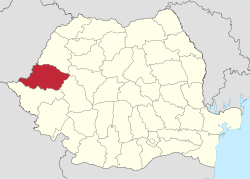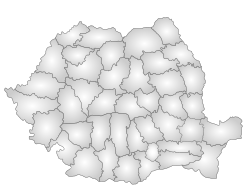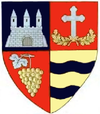This is an old revision of this page, as edited by Biruitorul (talk | contribs) at 21:34, 29 August 2011 (m). The present address (URL) is a permanent link to this revision, which may differ significantly from the current revision.
Revision as of 21:34, 29 August 2011 by Biruitorul (talk | contribs) (m)(diff) ← Previous revision | Latest revision (diff) | Newer revision → (diff) For other uses, see Arad (disambiguation). County in Vest, Romania| Arad | |
|---|---|
| County (Județ) | |
 Coat of arms Coat of arms | |
 | |
| Country | |
| Development region | Vest |
| Historic region | Crişana |
| Capital city (Resedinta de județ) | Arad |
| Județul Arad | 1968 |
| Government | |
| • Type | County Council |
| • President of the County Board | Nicolae Ioțcu (PDL) |
| • Prefect | Călin Bibarț |
| Area | |
| • Total | 7,754 km (2,994 sq mi) |
| • Rank | 5th in Romania |
| Elevation | 1,486 m (4,875 ft) |
| Population | |
| • Total | 461,791 |
| • Rank | 21st in Romania |
| • Density | 60/km (200/sq mi) |
| Time zone | UTC+2 (EET) |
| • Summer (DST) | UTC+3 (EEST) |
| Postal Code | 31wxyz |
| Area code | +40 x57 |
| Car Plates | AR |
| GDP | US$ 5.24 billion (2008) |
| GDP/capita | US$ 11,337 (2008) |
| Website | County Council County Prefecture |
| The development regions of Romania have no administrative role and were formed in order to manage funds from the European Union. as of 2007, the Prefect is not a politician, but a public functionary. He (or she) is not allowed to be a member of a political party, and is banned from having any political activity in the first six months after his resignation (or exclusion) from the public functionaries' corps. w, x, y, and z are digits that indicate the city, the street, part of the street, or eaven the building of the address x is a digit indicating the operator: 2 for the former national operator, Romtelecom, and 3 for the other ground telephone networks used on both the plates of the vehicles that operate only in the county limits (like utilitary vehicles and ATVs, etc.), and the ones used outside the county | |
Arad (Template:IPA-ro; Template:Lang-hu, Template:Lang-sr) is a administrative division (judeţ) of Romania roughly translated into county in the western part of the country on the border with Hungary, mostly in the region of Crişana and few villages in Banat. The administrative center of the county lies in the city of Arad. The Arad County is part of the Danube-Kris-Mures-Tisza Euroregion.
Geography
The county has a total area of 7,754 km², representing 3.6% of national Romanian territory. The terrain of Arad County is divided into two distinct units that cover almost half of the county each. The eastern side of the county has a hilly to low mountainous terrain (Dealurile Lipovei, Munţii Zărandului, Munţii Codru Moma) and on the western side it's a plain zone known as The Western Romanian Plain with its most known entities such as Arad Plain, Low Mures Plain, and The High Vinga Plain. Taking altitude into account we notice that it follows a stepped pattern as it drops as we go from the east to the west of the county from 1489 m to below 100 m. In the east there are the Zarand Mountainsnand the Codru Moma Mountains, all subdivisions of the Apuseni Mountains, a major group of the Western Carpathians.
Neighbours
 AB
AR
AG
BC
BH
BN
BT
BV
BR
BZ
CS
CL
CJ
CT
CV
DB
DJ
GL
GR
GJ
HR
HD
IL
IS
IF
MM
MH
MS
NT
OT
PH
SM
SJ
SB
SV
TR
TM
TL
VS
VL
VN
B
AB
AR
AG
BC
BH
BN
BT
BV
BR
BZ
CS
CL
CJ
CT
CV
DB
DJ
GL
GR
GJ
HR
HD
IL
IS
IF
MM
MH
MS
NT
OT
PH
SM
SJ
SB
SV
TR
TM
TL
VS
VL
VN
B
- Alba County and Hunedoara County to the East.
- Hungary to the West - Békés and Csongrád Counties.
- Bihor County to the North.
- Timiş County to the South.
Climate and precipitation
In terms of climate, the characteristics of Arad county have a typical temperate continental climate with oceanic influences, with a circulation of air masses with a predominantly western ordered direction visible from west to east, with increasing altitude. Average annual temperatures range from 10 °C in the lowlands, the hills and piedmonts 9 °C, 8 °C and 6 °C in the low mountains in the area of greatest height. Average amounts of precipitation fall in values between 565–600 mm annually in the lowlands, 700–800 mm annually in the hills and piedmonts and 800–1200 mm annually in the mountainous area.
Hydrographic network
The hydrographic network is composed of the two main rivers plus their tributaries and channels.
- Mureṣ - Valea Corbeṣti, Troaṣ, Bârzava, Milova, Cladova
- Criṣul Alb - Hălmăgel, Leuci, Tăcășele, Cremenoasa, Zimbru, Valea Deznei, Valea Monesei, Tălagiu, Honțisor, Chisindia, Cigher
Lakes, ponds and channels
- Tauț, Seleuș, Cermei, Rovine, Matca (Ghioroc) Lakes and Gypsy Pond
- Matca, Morilor, Ier, Criș Channels
Demographics
In 1720, the population was as follows - 374 houses:
- 177 Romanian (47.33%)
- 162 Serb (43.31%)
- 35 Hungarian (9.36%)
In 2002, it had a population of 461,791 and the population density was 60/km². The ethnic composition was, as follows:
- Romanians - 82.2%
- Hungarians - 10.7%
- Roma - 3.8%
- Slovaks - 1.2%
- Germans - 1.1%
- others - 1%
| Year | County population |
|---|---|
| 1948 | 476,207 |
| 1956 | 475,620 |
| 1966 | 481,248 |
| 1977 | 512,020 |
| 1992 | 487,617 |
| 2002 | 461,791 |
Economy
Along with Timiş County it forms one of the most developed regions in Romania. Due to its proximity to the border, it attracts a great number of foreign investments. The agricultural potential is greatly put into value, Arad plains being considered one of the most important ceral and legume producing basins.
The predominant industries in the county are:
- Machine and automotive components.
- Food.
- Textiles.
Natural resources in Arad, are worthy to be taken into account as there are oil and associated gases, points of extraction in the west of he county, molibden mines in the Săvârșin area, marble quarries at Căprioara and Moneasa, mineral waters at Lipova, Moneasa, Dorobanți, Curtici, Macea and uranium deposits in the NE part of the county.
Tourism
The main tourist destinations are:
- The city of Arad
- The Mureș Natural Floodplain Park
- Bezdin Monastery
- Hodoș-Bodrog Monastery (est. 1177)
- Lipova resort and city
- Șoimoș, Dezna, Șiria stone citadels
- Moneasa resort
- The areas around Săvârşin, Petriş, Macea and Pecica.
Administrative divisions
Arad County has 1 municipality, 9 towns and 68 communes with approximately 180 villages.
- Municipalities
- Arad - capital city; population: 172,827 (as of 2002)
- Towns
- Communes
- Almaş
- Apateu
- Archiş
- Bata
- Bârsa
- Bârzava
- Beliu
- Birchiş
- Bocsig
- Brazii
- Buteni
- Cărand
- Cermei
- Chisindia
- Conop
- Covăsânţ
- Craiva
- Dezna
- Dieci
- Dorobanţi
- Fântânele
- Felnac
- Frumuşeni
- Ghioroc
- Grăniceri
- Gurahonţ
- Hălmagiu
- Hălmăgel
- Hăşmaş
- Igneşti
- Iratoşu
- Livada
- Macea
- Mişca
- Moneasa
- Olari
- Păuliş
- Peregu Mare
- Petriş
- Pilu
- Pleşcuţa
- Săvârşin
- Secusigiu
- Seleuş
- Semlac
- Sintea Mare
- Socodor
- Şagu
- Şeitin
- Şepreuş
- Şicula
- Şilindia
- Şimand
- Şiria
- Şiştarovăţ
- Şofronea
- Tauţ
- Târnova
- Ususău
- Vărădia de Mureş
- Vârfurile
- Vinga
- Vladimirescu
- Zăbrani
- Zădăreni
- Zărand
- Zerind
- Zimandu Nou
References
Notes
- National Institute of Statistics, "Populaţia după etnie"
- National Institute of Statistics, "Populaţia la recensămintele din anii 1948, 1956, 1966, 1977, 1992 şi 2002"
External links
Categories:
